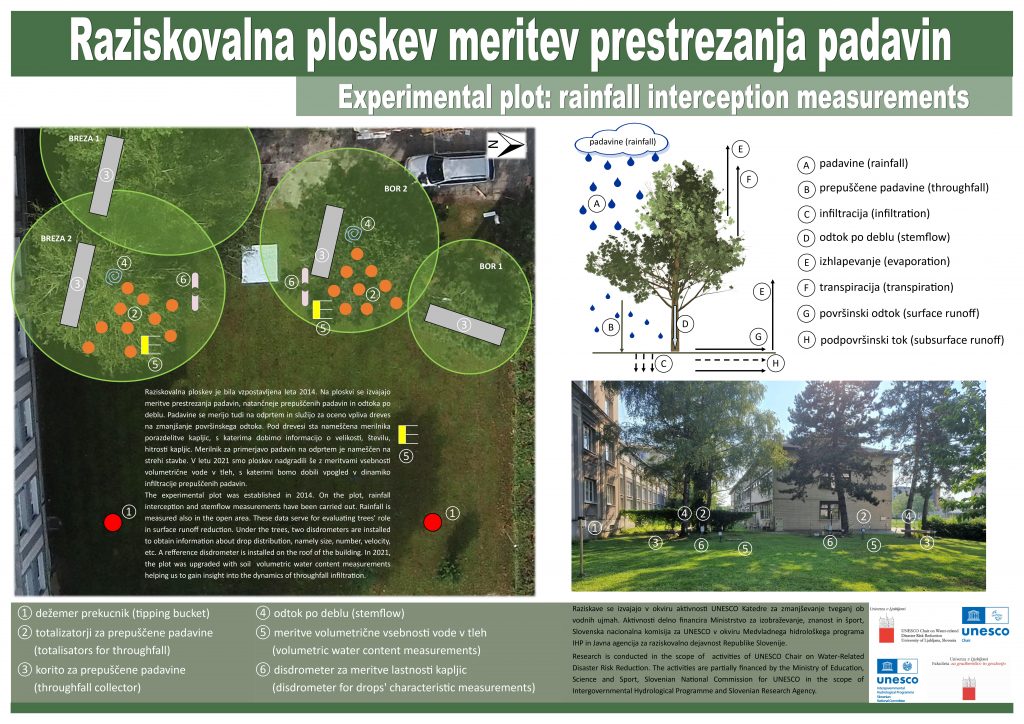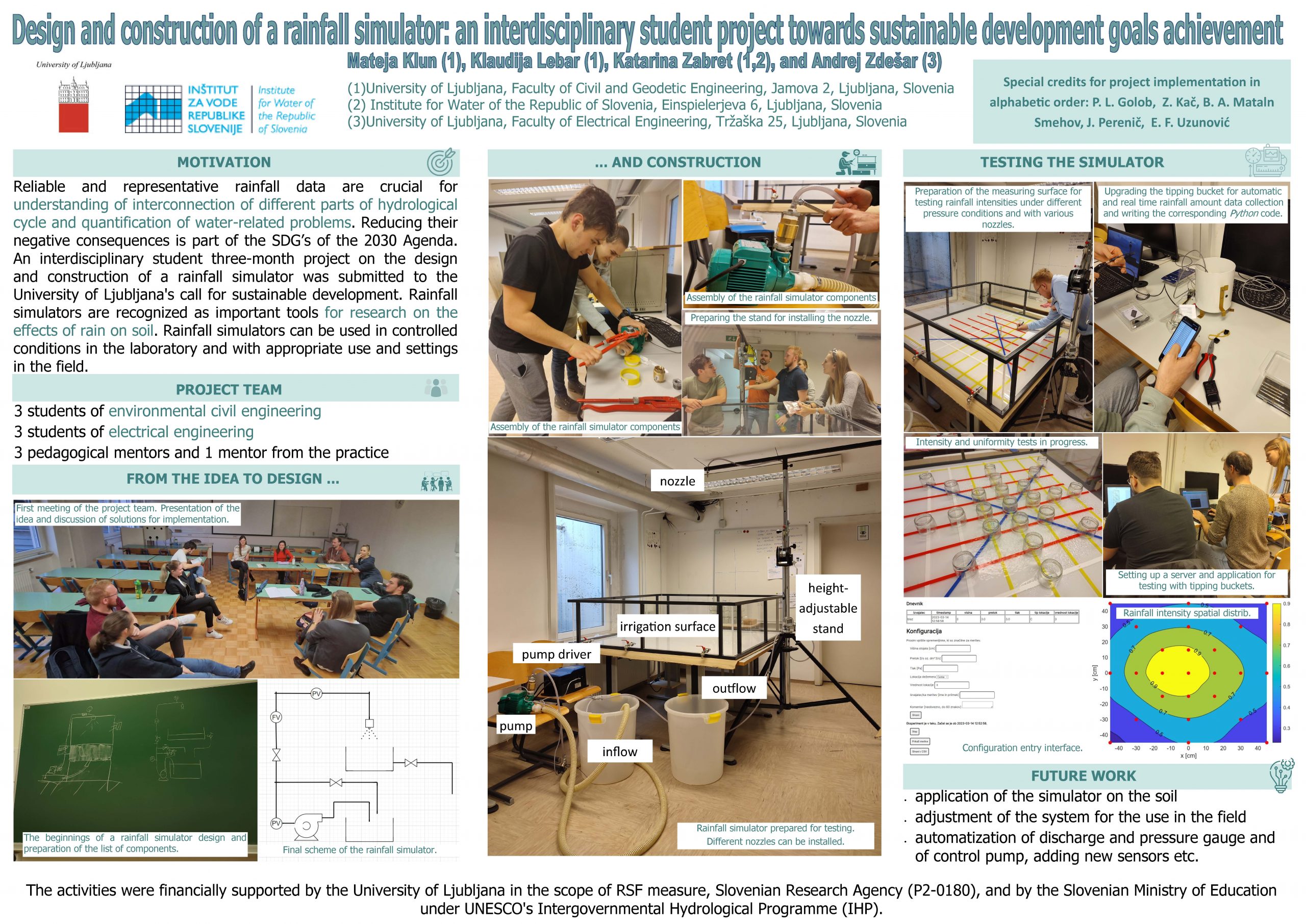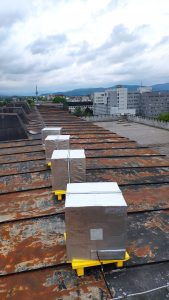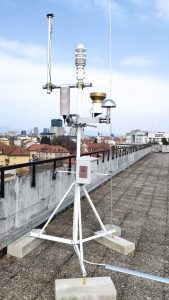UL FGG Laboratory for Aggregates
At UL FGG, the unit called Research Institute for Geo- and Hydro-Threats was established (RIGHT) in 2014. Its activity in the academic years is available as a pdf document: 2019/20 & 2020/21, 2017/18 & 2018/19 and 2015/16 & 2016/17.
The RIGHT Institute established a Laboratory for Aggregates that’s on ~50 m2 laboratory room a home to the following laboratory equipment:
Aggregate impact value machine A080 KIT
The aggregate impact value apparatus is used to determine the impact value of aggregates and select them for a given application. The machine has a trip-action hammer release, blow counter device, and a built-in operator safety device.
More information at: https://www.matest.com/en/aggregates-rocks/aggregate-impact-value-apparatus/
Freeze-thaw tester Schleibinger Slabtester
The freeze-thaw tester is used for testing resistance of natural material, concrete, tiles, and tile-glues to freeze-thaw cycles. The machine is equipped with two temperature sensors inside the chamber, the flooding option unit, and cans for aggregate testing.
More information at: http://www.schleibinger.com/cmsimple/en/?Durability:Slabtester
Density frame Matest
A density frame is used for the determination of concrete and aggregates specific gravity.
More information at: https://www.matest.com/en/general-equipment/specific-gravity-frame/
Digital point load tester Wille LP 4500
The point load test is a standard method to classify rock specimens. The point load is used to determine the strength of rock specimens. The rock specimen is loaded in between two load introduction tips with a concentrated force until it breaks. The test result is the point load index, which is used to classify or to characterize the rock. The UCS (uniaxial compressive strength) can then be estimated from the point load strength index using empirical formulae.
The tester is equipped with a safety screen/splinter protection, a digital axial strain measurement device, a hand-operated hydraulic pump, and a digital manometer. The tester is suitable for testing samples up to 120 mm in diameter, in the laboratory or in the field.
More information at: https://www.wille-geotechnik.com/en/portable-point-load-test-apparatus.html
Drying oven GENLAB SOIL SDO/225
Soil drying oven, designed for drying large quantities of soil and aggregate samples. The oven maintains temperature according to standard requirements (BS EN and ASTM). Equipped with the control system. The capacity of the oven is 210 L.
More information at: https://www.genlab.co.uk/41-soils-drying-ovens
Dynamic image analyser Microtrac Camsizer XL
A large particle size and shape analyzer is suitable for non-contact measurements of particles in the range between 160 µm and 135 mm. The analyzer measures 40 size, shape, and surface roughness parameters (including 33 3D parameters) in one analysis. The 3D parameter values are obtained from a series of different-angle images of a particle captured by a high-speed camera.
More information at: https://www.microtrac.com/products/particle-size-shape-analysis/dynamic-image-analysis/camsizer-xl/
Large-capacity sample splitter Controls
Sample splitter with adjustable openings from 12.5 to 150 mm, with 12.5 mm increments. Completed with two pans. The sample splitter is used to reduce large samples.
More information at: https://www.controls-group.com/eng/sample-splitters/large-capacity-sample-splitter.php
Leeb hardness tester Proceq – Piccolo 2
Leeb hardness tester is an apparatus similar to Schmidt’s hammer. It assesses the hardness of material according to the rebound value of the impact body. In contrast to Schmidt’s hammer, the Leeb hardness tester has lower impact energies and thus can be used on softer materials. The test (and apparatus) was originally intended for metals testing, but recently, it was recognized as a good alternative to Schmidt’s hammer for softer rock/mineral material.
More information at: https://www.screeningeagle.com/en/products/equotip-piccolo-2-bambino-2
Los Angeles machine Matest A0756
Los Angeles machine is used to determine the resistance of aggregates to abrasion (due to a combination of abrasion and fragmentation). The machine consists of a steel cylinder mounted on a frame. A cylinder drum has dimensions of 711 mm inner diameter and 508 mm inner length. The cylinder rotates at 31-33 rpm. The number of revolutions for a test is set on an automatic counter. The machine is equipped with a safety cabinet with an automatic safety switch. The machine is equipped with a set of steel abrasive charge A076-02
More information at: https://www.matest.com/en/product/a075n-los-angeles-machine
Manual sieves Haver and Boecker wooden frame
Light test sieves with beechwood frames are suitable for hand screening of coarse material (to determine particle size distribution).
Available sieves (300×300 mm wooden frame with perforated plate): 8mm, 11.2mm, 16mm, 22.4mm, 31.5mm, 45mm, 50mm, 63mm, 75mm, 90mm, 100mm
More information at: https://www.haverboecker.com/en/product-solutions/particle-analysis/sieve-analysis/test-sieves/
Micro-Deval apparatus Matest A077-01
Micro-Deval apparatus is used to determine the resistance of aggregates to abrasion. The machine consists of a steel frame and four steel cylinders. The cylinders have dimensions of 500 mm inner diameter and inner 154 mm length. The cylinders rotate at 100 rpm. The number of revolutions for a test is set on an automatic counter. The machine is equipped with a safety cabinet with an automatic safety switch. The machine is equipped with a set of steel abrasive charge A078-11N
More information at: https://www.matest.com/en/product/a077-01-micro-deval-machine-with-safety-cabinet
Needle penetrometer Maruto
A needle penetrometer is used for indirect assessment of UCS (uniaxial compressive strength) of soft rock material, according to penetration depth and force of the needle. The body of the penetrometer is equipped with a correlation diagram between the needle penetration gradient and UCS. The apparatus can be used in situ or in the laboratory.
More information at: http://www.maruto-group.co.jp/products/post-105.html
Pario particle size analyser
PARIO automated particle size analyzer allows automated soil particle size analysis. It calculates the particle size distribution by Stokes’ law, with a range spanning from 63 µm to 2 µm.
More information at: https://www.metergroup.com/en/meter-environment/products/pario-soil-texture-particle-size-analysis
Pocket vane tester Eijkelkamp
The pocket vane tester is a soil testing instrument for the rapid determination of the shear strength of cohesive soils, either in the field or in the laboratory. The vane tester is equipped with three rings for a wide measuring range (0-0.2; 0-1, and 0-2.5 kg/cm2). Maximum shear stress 250 kPa.
More information at: https://www.royaleijkelkamp.com/products/field-measuring-equipment/shear-stress/mechanical/pocket-vane-tester-set-with-3-vanes/?langchosen=1
Scales
- KERN ADB: precise scale 0.0001 g accuracy
More information at: https://www.kern-sohn.com/shop/en/laboratory-balances/analytical-balances/ADB/ADJ/
- KERN DS 3K0.01 scale with 0.01 g accuracy
More information at: https://www.kern-sohn.com/shop/en/industrial-scales/platform-scales/DS/
- KERN DS 20K0.1 platform balance scale with 0.1 g accuracy
More information at: https://www.kern-sohn.com/shop/en/industrial-scales/platform-scales/DS/
Screens Gilson TM-3F
Testing screens enable sieving (to determine particle size distribution) of large samples. Vibration characteristics are suitable for coarse material of mid-range density (e.g. limestone gravel aggregates). The machine is equipped with a hopper for the incremental introduction of samples, as the machine is running.
Available screen trays: 2.8 mm, 4 mm, 8 mm, 12.5 mm, 16 mm, 25 mm, 31.5 mm, 50 mm, 63 mm, 75 mm, 90 mm, 100 mm.
More information at: https://www.globalgilson.com/gilson-test-master-testing-screens
Sieve shaker Haver and Boecker EML-450 digital plus T
An electromagnetic sieve shaker for dry sieving enables the determination of particle size distribution. It can process up to 15 kg of bulk material per test. Sieving time, time intervals, and amplitude can be set on a control gear. It can hold sieves up to 450 mm in diameter.
Available sieves:
- CONTROLS perforated metal plate sieves: 450 mm: 4mm, 5mm, 5.6mm, 6.3mm, 8mm, 10mm, 11.2mm, 12.5mm, 14mm, 16 mm, 20mm, 22.4mm, 25mm, 31.5 mm, 37.5mm, 40mm, 45mm, 50mm
- CONTROLS woven wire cloth sieves: 200 mm: 0.063mm, 0.090mm, 0.125mm, 0.180 mm, 0.200 mm, 0.250 mm, 0.355 mm, 0.500 mm, 0.630 mm, 0.710 mm, 1mm, 1.4mm, 1.6mm, 1.7mm, 2.0mm, 2.36 mm, 2.8 mm
More information at: https://www.haverboecker.com/en/produktloesungen/particle-analysis/sieve-analysis/haver-test-screening-machines/ (sieve shaker)
https://www.controls-group.com/eng/aggregate-testing-equipment/sieves.php (sieves)
Slake durability tester CONTROLS 45-D046
The apparatus is compliant with standard ASTM D4644 for assessing the deterioration of rocks over a period of time when subjected to water immersion. The apparatus consists of a motorized drive unit mounted on a baseplate and connected to two or four drums that rotate at a speed of 20 rpm. The test drums are manufactured from a 2.0 mm mesh, 140 mm dia. x 100 mm long. The machine is equipped with a digital display for visualization of the residual testing time. The water level is indicated by a mark on the tanks, for correct water filling. The machine is equipped with 4 drums (and tanks) for simultaneous testing.
More information at: https://www.controls-group.com/eng/abrasion-durability/slake-durability-apparatus.php
Ultrasonic Unit Haver and Boecker HAVER USC 200 S
The ultrasonic cleaning unit is designed for the treatment of items and liquids. The process creates tiny vacuum bubbles which implode due to the variations of pressure caused by the ultrasonic activity. Highly energetic liquid jets remove dirty particles from surfaces. The unit is mainly used for cleaning of the sieves (200 mm diameter).
More information at: https://www.haverboecker.com/en/product-solutions/particle-analysis/sieve-analysis/screen-cleaning-devices/
We see 3D David – HP 3D scanner
The 3D scanner is equipped with a stereo camera upgrade kit, turntable, rail and tripod, and calibration panel.
More information at: https://support.hp.com/si-en/document/c05250654
Experimental plot: rainfall interception

Rainfall simulator: Student project

An interdisciplinary student project on the design and construction of a rainfall simulator was submitted to the University of Ljubljana’s call for sustainable development student projects. Precipitation is one of the essential parts of the hydrological cycle. Rainfall simulators are recognized as important tools for studying the effects of rain on soil. Rainfall simulators can be used in controlled conditions in the laboratory or with additional settings also in the field. In the scope of the project a team of six students of environmental civil engineering and electrical engineering under the supervision of the mentors designed and constructed a physical rainfall simulator. The project work included the choice of pipe materials, pump capacity, size and type of spray nozzles, development of a control system for monitoring and recording of results, and, last but not least, the determination of rain properties we would like to simulate. With such a project, group work and co-creation is encouraged among students, theoretical knowledge acquired within the curriculum is transferred into practice and knowledge is exchanged between different disciplines. Skills such as communication, critical thinking, organization of tasks and time management, interdisciplinary problem solving, analytical reasoning, information and technology literacy, are developed in the project. Additionally, such equipment will be used for teaching and research purposes in the future, which is another sustainable feature of this project.
UL FGG Weather Station
We are running a Weather Station on the roof of the University of Ljubljana, Faculty of Civil and Geodetic Engineering main building, Jamova cesta 2 in Ljubljana (see photo below).
Numerous parameters are measured by diverse equipment, including:
- Lufft Weather Station WS-700
- Classic Rain gauge
- Sommer Messtechnik RHD Rain disdrometer and hail detection sensor
- Apogee SP-510-SS upward-looking Thermopile Pyranometer
- Stevens eTracker – the gateway to the cloud for data storage
You are invited to look at the measured meteorological values by visiting this web page.
UL FGG – A polygon for measuring surface heating due to solar irradiation.
We are running a thermal response to solar irradiation for vertical polished rock surfaces (area 10 x 10 cm, limestone rock) on the roof of the University of Ljubljana, Faculty of Civil and Geodetic Engineering main building, Jamova cesta 2 in Ljubljana (see photo below).
Temperatures of the rock sample (10 x 10 x 20 cm) at 1 cm depth and 20 cm depth are measured for the four cardinal directions of the sky (E, W, S, and N) using:
- HOBO TidbiT MX Temperature 400 Data Loggers
- HOBO MX2303 External Temperature Sensors Data Loggers
- HOBOlink – the gateway to the cloud for data storage
You are invited to look at the measured temperature values by visiting this web page.

Links to Useful Field Equipment
New Optical Turbidity Sensor 4296 from Aanderaa.
YSI Multiparameter Sondes. New YSI portable EXO NitraLED UV Nitrate Sensor for freshwater environments.
Link to Field Equipment at UL FGG

